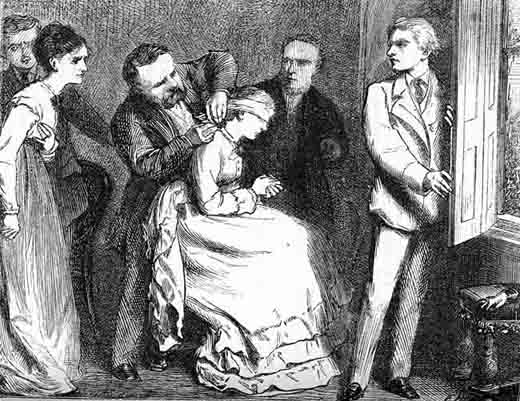Dear Serial Readers,
On the lacking of the "clerical" in this story about Mr. Gilfil, the Shepperton rector who preceded Amos Barton of the first SCENE: maybe Eliot's point is that clerical life, like realism, is ordinary and secular. Notwithstanding the protracted botanical metaphor of Gilfil as a " whimsical misshapen trunk" (due to heartbreak over that "delicate plant" that died "in the struggle to put forth a blossom"--did Caterina die in childbirth?), this story concludes with the suggestion that Gilfil's "love-story" of long ago made him a better clergyman, a more compassionate presence than a doctrinal expert.
I found myself impatient with the story, and I'm not sure it was simply because I knew the ending near the outset (some of you know my agnosticism on readerly suspense). I found the writing at times too maudlin, overgrown with those botanical flourishes. I even had this suspicion: did Eliot write this story entirely, or did Lewes have a larger helping hand?
Yet here are some aspects that intrigued me:
*Caterina's dagger--her desire to murder Anthony, and Maynard's refusal to believe she would actually be capable of this deed--shades of other Eliotic women would-be or otherwise murderers (from Hetty Sorrel to Madame Laure and Gwendolen Harleth) and men who cannot fathom them as such.
*All the chapter divisions--this story has many very short chapters; I'm not sure what this means in terms of the serial parcel, but I found many sub-scenes within this larger scene.
*The verb tense shifts (as Julia noted)--the use of the present tense to generate suspense, excitement, or immediacy-- a way to insert the reader into the story.
*The scene shifts between humble homes and Cheverel Manor (between realism and romance), even between provincial England and Italy.
*There were elements that also reminded me of JANE EYRE (Caterina fleeing Cheverel Manor, and her vulnerability to the seductions of Anthony who cannot marry her) and AURORA LEIGH (the transplant of the Italian child onto English soil)
Next up: our third and final "SCENE"--"Janet's Repentance" (chaps 1-4).
Thanks, Kari, for mentioning the photographs from the 1907 edition. Are there ones that accompany the other stories in SCENES too?
Serially scenic,
Susan

1 comment:
I too was struck by how often Eliot returns to women murderers or would-be murderers: Caterina, then Hetty Sorrel, Madame Laure, and Gwendolyn (whose confession to Deronda is *remarkably* similar to Caterina's to Gilfil with the important difference that Deronda isn't a clergyman--as Eliot reminds us--and isn't in love with Gwendolyn--or only sort of). This return to murder seems so sensationalist and melodramatic and un-Eliotic--and yet so insistent in her work. I'm finding myself surprised and puzzled by it. I think part of what bothers me about Caterina is that she's a stereotype of Latin passion, and that made me think about Eliot's other near-murderers: one Italian, one working class, one French, and only the very last a member of the British upper classes. Caterina and Gwendolyn both refrain from actually committing murder, and they and Hetty repent. Not so Madame Laure, with her willingness to claim responsibility: "I meant to do it." (Chilling!) What do we make of a realism so bent on thinking about murder?
Post a Comment